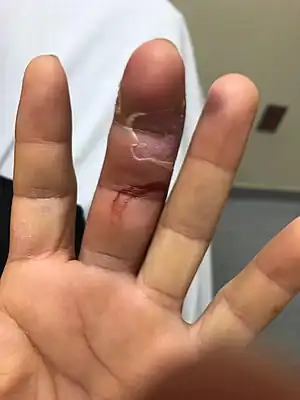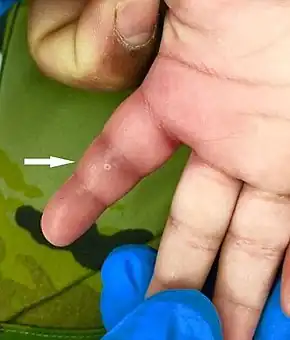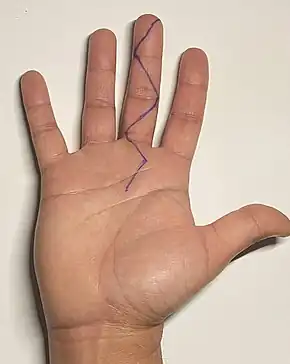Infectious tenosynovitis
| Infectious tenosynovitis | |
|---|---|
| Other names: Pyogenic tenosynovitis, suppurative tenosynovitis,[1] septic tenosynovitis[2] | |
 | |
| Infectious flexor tenosynovitis of the middle finger | |
| Specialty | Hand surgery (orthopedics or plastic surgery) |
| Symptoms | Tenderness, slightly flexed finger, pain with straightening, swelling[1] |
| Complications | Stiffness, tendon rupture, amputation[1] |
| Risk factors | Diabetes, intravenous drug use[3] |
| Diagnostic method | Based on examination[1] |
| Differential diagnosis | Felon, joint infection, herpetic whitlow, cellulitis[1] |
| Treatment | Antibiotics, splinting, surgery[1] |
| Frequency | Rare[4] |
Infectious tenosynovitis is a bacterial infection within a tendon sheath.[1] Typical symptoms, when a flexor tendon of a finger is affected, include tenderness of the area, a slightly flexed finger, pain with straightening, and swelling of the entire finger.[1] Fever is present in about 20% of cases.[1] Other relatively commonly affected areas include the wrist and foot.[5]
Infections may occur following an injury, such as a cut or bite, or spread from elsewhere in the body.[1] Risks include diabetes and intravenous drug use.[3] The bacteria involved is most commonly Staphylococcus aureus; with other potentially including Pseudomonas aeruginosa, Pasteurella multocida, and gonococcus.[1] Diagnosis is generally based on examination.[1] Medical imaging may support the diagnosis and rule out other complications.[1]
Infection of the flexor tendons of the hand require rapid treatment.[1] Mild cases may be managed with intravenous antibiotics and splinting; while more severe cases also require surgery.[1] Occasionally amputation is required.[1] About 10% to 25% of people have some permanent loss of range of movement.[1] Other complications may include tendon rupture and trigger finger.[1][2]
Infectious tenosynovitis is rare, occuring in about 2.5% o 9.5% of hand infections.[1][4] The classic presentation of the condition was first described in 1912 by Allen Kanavel.[1] He also put forwards the importance of surgical drainage as a key part of management.[6]
Signs and symptoms

Kanavel's cardinal signs is used to diagnose infectious tenosynovitis. They are: tenderness to touch along the flexor aspect of the finger, fusiform enlargement of the affected finger, the finger being held in slight flexion at rest, and significant pain with passive extension.[7][8] Fever may also be present but is uncommon.[9]
Cause
Infectious tenosynovitis is infection of closed synovial sheaths in the flexor tendons of the fingers. It is usually caused by trauma, but bacteria can spread from other sites of the body. Although tenosynovitis usually affects the flexor tendon of the fingers, the disease can also affect the extensor tendons.[10] The presentation maybe an acute infection following trauma. The infection can be mono- or polymicrobial and can vary depending on the nature of the trauma.
The most common pathogen is Staphylococcus aureus introduced from the skin.[11] Other bacteria may include Pasteurella multocida (associated with animal bites), Eikenella spp. (associated with IV drug use), and Mycobacterium marinum (associated with wounds exposed to fresh or salt water).[12] Additionally, sexually active people are at risk for hematogenous spread due to Neisseria gonorrhoeae (see infectious arthritis).
Treatment
The mainstay of treatment for infectious tenosynovitis includes symptom relief, antibiotics, and surgery. Early recognition with early antibiotics are important for better range of movement of the affected finger.
Surgery

Minimally invasive procedures into the flexor tendon sheath such as catheter irrigation give better outcomes (74% chance of good outcome) when compared to open surgery (26% chance of good outcome). However, wound irrigation with antibiotics has no clear benefits.[7] Most infectious tenosynovitis cases should be managed with tendon sheath irrigation and drainage, with or without debridement of surrounding necrotic tissue.[10] In severe cases, amputation may be necessary to prevent the further spread of infection. Following surgical intervention, antibiotic therapy is continued and adjusted based on the results of the fluid culture.[10]
Prognosis
The earlier the condition is identified, the better the chance of getting full range of motion of the finger. However, finger stiffness, Boutonniere deformity, deep space infection, tendon necrosis, adhesions, persistent infection, and need for amputation of the finger can occur. Tendon adhesion and finger stiffness are caused by the violation of the flexor tendon sheath.[7]
Epidemiology
Infectious tenosynovitis occur in about 2.5% and 9.4% of hand infections.[5]
References
- 1 2 3 4 5 6 7 8 9 10 11 12 13 14 15 16 17 18 19 20 Hermena, S; Tiwari, V (January 2022). "Pyogenic Flexor Tenosynovitis". PMID 35015439.
{{cite journal}}: Cite journal requires|journal=(help) - 1 2 Feger, Joachim. "Infectious tenosynovitis | Radiology Reference Article | Radiopaedia.org". Radiopaedia. Archived from the original on 30 April 2022. Retrieved 22 June 2022.
- 1 2 "Pyogenic Flexor Tenosynovitis - Hand - Orthobullets". www.orthobullets.com. Archived from the original on 29 December 2021. Retrieved 22 June 2022.
- 1 2 Joshi, Jayant; Kotwal, Prakash P. (28 October 2016). Essentials of Orthopaedics & Applied Physiotherapy - E-Book. Elsevier Health Sciences. p. 549. ISBN 978-81-312-4030-4. Archived from the original on 10 July 2022. Retrieved 22 June 2022.
- 1 2 Ray, G; Sandean, DP; Tall, MA (January 2022). "Tenosynovitis". PMID 31335044.
{{cite journal}}: Cite journal requires|journal=(help) - ↑ Chang, James; Neligan, Peter C. (9 August 2017). Plastic Surgery E-Book: Volume 6: Hand and Upper Limb. Elsevier Health Sciences. p. PA355-IA3. ISBN 978-0-323-35713-5. Archived from the original on 10 July 2022. Retrieved 22 June 2022.
- 1 2 3 Avira M, Giladi; Sunitha, Malay; Kevin, C Chung (23 March 2016). "Management of acute pyogenic flexor tenosynovitis: Literature review and current trends". Journal of Hand Surgery (European Volume). 40 (7): 720–728. doi:10.1177/1753193415570248. PMC 4804717. PMID 25670687.
- ↑ Pang, HN; Teoh, LC; Yam, AK; Lee, JY; Puhaindran, ME; Tan, AB (August 2007). "Factors affecting the prognosis of pyogenic flexor tenosynovitis". The Journal of Bone and Joint Surgery. American Volume. 89 (8): 1742–8. doi:10.2106/JBJS.F.01356. PMID 17671013.
- ↑ Nikkhah, D; Rodrigues, J; Osman, K; Dejager, L (2012). "Pyogenic flexor tenosynovitis: one year's experience at a UK hand unit and a review of the current literature". Hand Surgery. 17 (2): 199–203. doi:10.1142/S0218810412500190. PMID 22745083.
- 1 2 3 Small, LN; Ross, JJ (December 2005). "Suppurative tenosynovitis and septic bursitis". Infectious Disease Clinics of North America. 19 (4): 991–1005, xi. doi:10.1016/j.idc.2005.08.002. PMID 16297744.
- ↑ Moses MD, Scott. "Suppurative Tenosynovitis". www.fpnotebook.com. Archived from the original on 2019-02-07. Retrieved 2020-12-26.
- ↑ Tsai, E; Failla, JM (May 1999). "Hand infections in the trauma patient". Hand Clinics. 15 (2): 373–86. PMID 10361644.
External links
- Archived 2021-12-29 at the Wayback Machine Ortho Bullets]